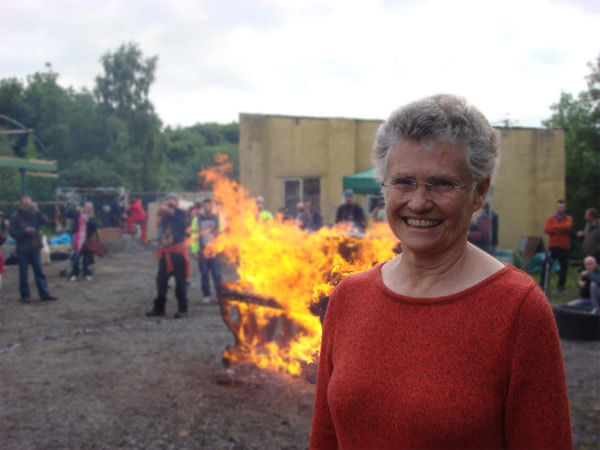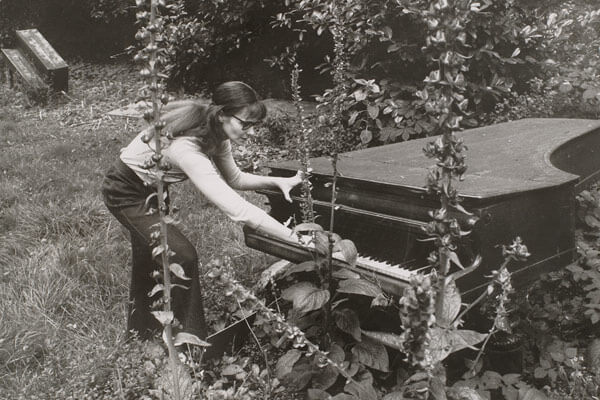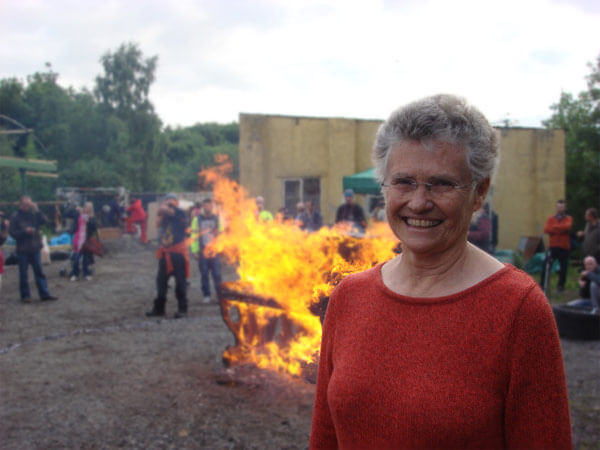Composer and sound artist Annea Lockwood is known for her explorations of natural acoustic environments in installation and concert works. During her recent trip to the UK, Annea oversaw the realization of the Piano Transplant series (1968 – 2005), which examine natural and assisted decay of instruments beyond repair. This gave us an opportunity to have a conversation.
In your 2004 interview with Frank J. Oteri, you mention the soundscape and landscape of New Zealand “triggering” some of your work. Several New Zealand composers have this special association. Do you think we can trace these influences directly in your music, or is it more subtle than that?
Living within that powerful NZ landscape has been the source of my long fascination with environmental forces and their sounds, for sure, though not in any direct, quasi-pictorial way. The three Piano Transplants installed recently depend upon fire, water and earth for their transformations: Eastern Exposure, the piano on the beach at Harwich, is exposed to the action of the North Sea’s waves and tides; the little upright partially buried in the Gwydyr Forest near Llanwrst, North Wales, will slowly decay; and you were a crucial participant in the burning of another upright near Bangor recently. My three Sound Maps of rivers (the Hudson, the Danube and the Housatonic) and my River Archive of the ’60s and ’70s came from my love of New Zealand’s wild rivers, my appreciation and experience of their rhythms and power.

Annea Lockwood during Piano Burning, photo by Xenia Pestova
In the same conversation, you talk about getting yourself “out of the way” and letting sounds come to the listener. This is a very Cagean notion… Can you tell us about your relationship with Cage and his influences on your approach to sound, art, life?
Cage’s seminal book, ‘Silence’, was a strong influence in my twenties, confirming my own sense that all sound is inherently musical and interesting, valuable. My work as a composer took off completely from that premise. As he was, generously with many young composers, he was always friendly, encouraging, when we met. For example, I remember him coming to a final rehearsal of Thousand Year Dreaming because he wasn’t able to come to the performance; a typically supportive action. This core conceptual influence on my music was his influence on my life and I’m profoundly grateful to him.
Let’s talk about technology. How much importance do you give to the quality of the gear – should the tools be “transparent” in serving art, or do they become instruments to play with along with their quirks and artefacts, adding to and coloring the results?
Much of the recording I do these days is field recording and here quality is paramount – the quality of my gear (currently a Sound Devices recorder and Shure and Sennheiser mikes), the sample and bit rates I use (currently 96K and 24 bits) and my studio software base is Pro Tools. And it is important to me that those tools be “transparent” to a listener. My aim, whether with rivers or interviews (as with the voices in A Sound Map of the Danube) is to bring a listener inside the river’s energies/sounds, the person/nature of someone reminiscing, for example. Of course the gear, the mikes especially, colors the sound inevitably but then so do my ears, and yours – a nice, personal given.
Thinking of the Piano Transplants, we can’t help but relate to the idea of the passage of time. This is of course an inevitable part of listening to any music or sound. How does the awareness of this temporal dimension influence your work?
Time and the transience of sound is so much the fundamental parameter of our work that awareness of it is also fundamental when one’s composing. I try to gauge how long a listener might stay engaged by the sounds of a particular site, in a Sound Map for instance, by the acoustic details and her body’s reactions to the sounds.
Musical time has long been duration, for me, not meter. A particular pleasure is working with silences; I sometimes push the length of a sound event or a silence in an attempt to calm the body or, as in the case of the long tone and following silence in the opening of In Our Name (settings of three poems by prisoners in Guantánamo), to generate unease. Time is a wonderful medium and the action of natural forces over time is the point of the Piano Transplants, as you suggest.

Annea Lockwood – Piano Garden (1969-70, Ingatestone, Essex)
I wonder what you think about the role of women composers and musicians today as compared to when you were starting your career. I find that the ratio is still uneven (especially amongst those working with technology). Is there anything we can do to encourage young women to pursue careers in music?
I think that there’s quite a lot more sensitivity to the visibility, should say ‘audibility’ really, of women composers and musicians now, but just looking at concert programs alone, there’s still too much programming which is entirely male. Yes, the ratio is still very uneven in terms of prominence, and yet this is a time in which young women composers, sound artists, performers proliferate, in every style and medium, to my delight. The low ratio of women students to men in academic electronic music studios remains a widespread concern, I find, in talking with studio heads, both male and, rarer, female in a number of countries. Women find their way into electronics nonetheless, and it’s much easier to do it outside academia now, of course, but the career support which comes from academic environments can be really helpful, so that low ratio is problematic.
Hard to know how to correct it though; male colleagues I’ve spoken with are as concerned about it as I. One terrific, practical response is a sort of summer camp which American composer, Suzanne Thorpe, is running for girls this summer, focused on working with electronic music software and hardware with the aim of giving them the chance to develop skills and a passion for the medium which will carry through into careers.




















